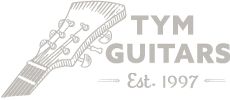1960's/70's Aria 1702 and 1720
Share
Being Mosrite (and Aria) fans there was always going to be a blog (or 2, or 3, or 4 or...) about the great little Aria 1702 guitars and basses. I just can't believe it's taken me this long. Well, I can, but ....

Aria is one of the better known Japanese brands, especially here in Australia where they were (and still are) imported to fill everything from beginners nylon strings to good quality players guitars. Of course ARIA was the brand name of the company formed in Japan in the mid 1950's for retailing acoustic guitars who teamed up with the GREAT Matsumoku factory in late '64 to make their guitars.
Matsumoku was on the best woodworking and guitar manufacturing factories in Japan and made guitars for many different brands like Victor, Silvertone, Elk and of course, Univox for the US market.


The Aria 1702 was introduced in 1968 just as the "boom" was starting to decline. Mosrites had been very popular in japan and many brands were making Mosrite copies and inspired guitars. Guyatone made quite a few, Excetro, Jaguar (more on them soon), Morales, Suzuki, Tokai, Elk and of course Fistman were all making guitars heavily influenced by Mosrite.
The 1702T was the guitar version and features a thin solid timber bodies with thin maple bolt on (24.75") necks. The first series of the 1702 had a slightly thicker body and featured rocker switches for pickup selectors. The German Carve was shallower on early versions too becoming more "fluid" on later Phase Is. More on them soon.

This is essentially exactly the same guitar as a "Phase II" Univox Hi-Flier as these were made for the US market by Matsumoku. We only got the Aria (or Arai for early versions) in Australia but they were bought here in decent enough numbers to see them pop up in second hand shops in the 80's/90's which was exciting for Mosrite starved youths.


Earlier "Phase I" versions had Aria Diamond logos along the headstock between the tuners which changed to Aria Diamond on the end of the headstock somewhere along the Phase I line which changed again to a badge in the Phase II stage. These changes are the same with early Univox versions too.


While these are Mosrite influenced, I would not consider them "Mosrite copies" as such. As I've discussed before Mosrite was a HUGE influence on these Japanese manufacturers but very few made anything close to an actual Mosrite in terms of accuracy and quality. It wasn't until Firstman/Mosrite Japan came long that I would consider anyone made an actual Mosrite copy in Japan although Morales came very close.
These are what would be considered a medium level affordable Japanese import for the time. Good quality in that Matsumoku made great guitars but not a Mosrite by a long shot. That's not to say they're not great guitars in their own right.


The body is significantly smaller and thinner than a real Mosrite although the influence and German carve is completely there. The necks are thin (like most late sixties Arias) and good quality with nice timber and finish. Early versions had a full string bar while Phase IIs had string trees on the inner four strings. The fretboards are always good quality and the necks are rarely warped or twisted as Matsumoku was a fine woodworking factory with great timber drying skills.
The pickups are Mosrite inspired P-90 style single coils and are GREAT. I do love these pickups a lot. They have great punch and clarity not unlike a real Mosrite pickup, although not as hot.

These Phase IIs have a standard three way toggle switch and master volume and tone control like a Mosrite.
The catalogue showed these available is sunburst, white and black only and this red burst is rare for one of these. I have seen this exact burst on Epiphone ET200's and the Victor/NIVICOs which were made in the same factory. These do pop up in other "custom" colours available from other Matsumoku made guitars at the time too.


The bridge is the standard Aria bridge for the time with plastic saddles on a steel base with adjustment for height and intonation. The vibrato is based on the ever popular offset unit as used by many Japanese manufactures. The quality of Aria hardware was always good and as I've said many times, it's a testament that "cheap" Japanese guitars can be completely original and fully functional after 50 years.

The bass version (1720) is essentially the same as the guitar version with a longer (short) scale neck (30") attached which was common on sixties Japanese guitars. These are harder to come by and don't show up very often, especially in Univox form which most tended to have the later (Phase III) humbuckers.

This is a Phase II bass with the headstock logo on the end of the headstock and the scratchplate without the cutaway for the pickup. I have seen this era, and earlier rocker switch versions branded as Princeton in the US and these were identical and made by Matsumoku.


Neither of these have the original knobs but (apart from the pots/switch in the bass) are mostly original and in great working order. These play well and sound great and can be used a heavy touring guitars as my friend Dimitri from OFF! (and Kurt) will testify to.


I've got some early Phase Is and other Aria stuff to blog about soon but until then, these are in the shop ready to rock.
